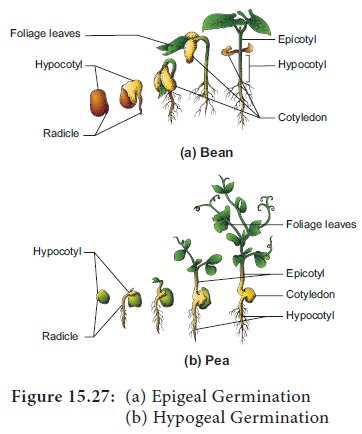Chapter: 11th Botany : Chapter 15 : Plant Growth and Development
Seed Germination and Dormancy

Seed Germination and Dormancy
I. Seed Germination
The
activation and growth of embryo from seed into seedling during favourable
conditions is called seed germination.
1. Types of germination
There are
two methods of seed germination. Epigeal and hypogeal.
i. Epigeal germination
During
epigeal germination cotyledons are pushed out of the soil. This happens due to
the elongation of the hypocotyl. Example: Castor and Bean.
ii. Hypogeal germination
During
hypogeal germination cotyledons remain below the soil due to rapid elongation
of epicotyls (Figure 15.27). Example: Maize

2. Factors affecting germination
Seed
germination is directly affected by external and internal factors:
i. External factors
a.
Water: It
activates the enzymes which digest
the complex reserve foods of the seed. If the water content of the seed goes
below a critical level, seeds fail to germinate.
b.
Temperature: Seeds
fails to germinate at very low and
high temperature. The optimum temperature is 25oC to 35oC
for most tropic species.
c.
Oxygen: It
is necessary for germination. Since aerobic respiration
is a physiological requirement for germination most will germinate well in air
containing 20% oxygen.
d.
Light: There
are many seeds which respond to
light for germination and these seeds said to be photoblastic.
e.
Soil
conditions: Germination of seed in its
natural habit is influenced by soil conditions such as water holding capacity,
mineral composition and aeration of the soil.
ii. Internal factors
a.
Maturity
of embryo: The seeds of some plants,
when shed will contain immature embryo. Such seeds germinate only after
maturation of embryo.
b.
Viability: Usually
seeds remain viable or living only for
a particular period. Viability of seeds range from a few days (Example: Oxalis) to more than hundred years.
Maximum viability (1000 years) has been recorded in lotus seeds. Seeds
germinate only within the period of viability.
c.
Dormancy: Seeds
of many plants are dormant at the
time of shedding. A detailed treatment is given below.
![]()
![]()
II. Seed Dormancy
The seeds
of most plants germinate under favourable environmental conditions but some
seeds do not germinate when suitable conditions like water, oxygen and
favourable temperature are not available. Germination of such seeds may be
delayed for days, months or years. The condition of a seed when it fails to
germinate even in suitable environmental condition is called seed dormancy. There are two main reasons for the development of
dormancy: Imposed dormancy and innate dormancy. Imposed dormancy is due to low
moisture and low temperature. Innate dormancy is related to the properties of
seed itself.
1. Factors causing dormancy of seeds:
a.
Hard, tough seed coat causes barrier effect as
impermeability of water, gas and restriction of the expansion of embryo
prevents seed germination.
b.
Many species of seeds produce imperfectly developed
embryos called rudimentary embryos which
promotes dormancy.
c.
Lack of specific light requirement leads to seed
dormancy.
d.
A range of temperatures either higher or lower
cause dormancy.
e.
The presence of inhibitors like phenolic compounds
which inhibits seed germination cause dormancy.
2. Methods of breaking dormancy:
The
dormancy of seeds can be broken by different methods. These are:
i.
Scarification:
Mechanical and chemical treatments
like cutting or chipping of hard tough seed coat and use of organic solvents to
remove waxy or fatty compounds are called as Scarification.
ii.
Impaction: In some
seeds water and oxygen are unable to
penetrate micropyle due to blockage by cork cells. These seeds are shaken
vigorously to remove the plug which is called Impaction.
iii.
Stratification: Seeds
of rosaceous plants (Apple, Plum,
Peach and Cherry) will not germinate until they have been exposed to well
aerated, moist condition under low temperature (0oC to 10oC)
for weeks to months. Such treatment is called Stratification.
iv.
Alternating
temperatures: Germination
of some seeds is strongly promoted by alternating daily temperatures. An
alternation of low and high temperature improves the germination of seeds.
v.
Light: The
dormancy of photoblastic seeds can
be broken by exposing them to red light.
Related Topics